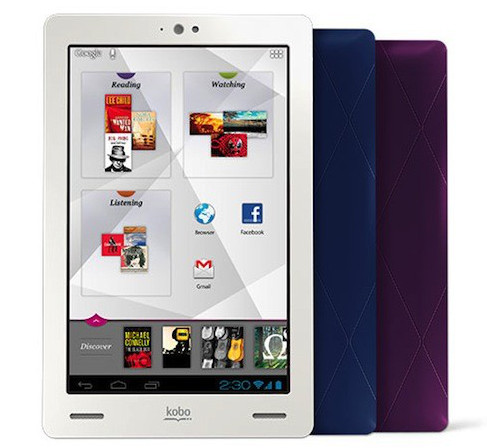Remember a couple of weeks ago when Kobo unexpectedly announced two new ebook readers and the Kobo Arc tablet on the morning of Amazon’s big Kindle press conference?
Now that Kobo knows what they are up against with the 7″ Kindle Fire HD, they are upping the storage configurations for their Kobo Arc tablet while maintaining the same price.
Initially Kobo said the Arc tablet would be available in 8GB and 16GB models. Now they are doing away with the 8GB model. The 16GB Kobo Arc will now be the base model and will sell for $199 (nice, it hasn’t even been released yet and is already getting a $50 price cut).
Kobo is also going to offer a 32GB model for $249 and a 64GB model for $299. The larger model is rather odd seeing as how there are a number of better tablets for that price, but I guess Kobo wanted to provide plenty of options.
In case you missed it, the Kobo Arc is a 7″ tablet with similar specs to the new Kindle Fire HD. It has a high resolution 1280 x 800 IPS screen, a 1.5GHz OMAP 4470 dual-core processor, 1GB of RAM, a front-facing 1.3MP camera, dual front-facing speakers, and it delivers 10 hours of battery life.
The main thing that separates the Kobo Arc from the Kindle Fire is the software. The Arc runs open Android 4.0, and the Kindle uses a closed-in custom version of Android 4.0. The Kobo supports Google apps and even comes with access to Google’s appstore, which has over 600,000 apps. The Kindle Fire on the other hand has to be hacked to get access to Google Play.
The Kobo Arc is expected to be released in mid-November. More information about the device can be found on Kobo’s website.
The folks at Engadget posted an early hands-on with the Kobo Arc. It has a custom homescreen that looks rather unique. Take a look:


Hey Dude,
This may be a stupid question but can you get the Kindle app on this Arc machine? I have loads of Kindle books and I need a machine which(although not necessarily a Kindle) can do Kindle books. Can you help?
Thanks mate.
That’s the beauty of Kobo’s approach: you can install whatever apps you want, including competing ereading apps, so the Kindle app should work no problem.
I have kindle on my vox… works great!
The 64GB option isn’t very odd at all. There are several factors at play here.
First, the Arc isn’t expandable. There is no way to expand once the memory is full (e.g., SD card slot). If tracking Amazon “8GB is too small for storing HD content” mindset then 16 and 32 GB aren’t all that large either.
Not sure Amazon is going to expand “download and play later” for their “Instant Video” to a mainstream Android app (they do for iOS so that would be a bit odd), their competitors will (e.g., Walmart/Vudu , etc. ). Several videos , a very large comic/graphic book collection , large number of photographs , etc. All of those can eat into 16GB pretty quickly.
Second, the expected margins on the $199 model probably just went down. Kobo can offset that by adding a higher end model with higher margins. In a optimal world, Kobo would sell a mix of the three models on a normal bell curve.
They won’t get perfect bell curve distribution and it is harder match production with consumption through intermediate vendors to the consumers for 3 product models versus 2, but done accurately it could be a win for Kobo and for consumers.
Third, while there will be “better” tablets at the $299 price point will those tablets have as much storage and be as small (i.e., easy to store/carry)? Different users are going to have different weightings on functionality for a given price point. “better” is a varies by individual preferences when applied across multiple dimensions.
For example Amazon Fire 8.9″ 16GB vs. Kobo Arc 7″ 32GB both at $299. ‘More screen , less storage , Amazon walled garden’ vs ‘less screen, more storage , Google Play garden’ They are differentiated on several dimensions besides price.
Arc vs. Nexus 7 is a different set of tradeoffs.